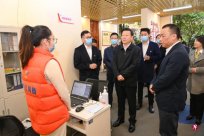China's March manufacturing restoration momentum has slowed down, and the FCB China Manufacturing Purchasing Manager Index (PMI) recorded 50.0, a decrease of 1.6 percentage points from February, falling on the Rongku Line.In February, Caixin China ’s manufacturing industry PMI recorded 51.6, and rose to the expansion range for the first time since August 2022.
According to China Caixin.com on Monday (April 3), after a brief expansion in February, China ’s manufacturing prosperity fell on the critical point in March, showing that the overall and top -ups of the manufacturing economic activities showedThe monthly holding the momentum slowly slows down.
The above trend is consistent with the PMI of the Manufacturing Industry of the National Bureau of Statistics of China.The March manufacturing PMI fell 0.7 percentage points to 51.9, which was announced on Friday (March 31st), which was announced on Friday (March 31), and was located in the expansion range for three consecutive months.
Sub -item data shows that the repairs of supply and demand in China have slowed down. In March, the manufacturing production index and the new order index fell in the expansion range, which was slightly higher than that of the Rongku line.Some interviewed companies report that they have benefited from the prevention and control of the epidemic, and the customer demand and quantity have improved, but some companies have said that the sales are relatively weak, especially overseas orders.In terms of division categories, China's consumer goods sales have grown, and the sales of intermediate products and investment products have declined.In addition, it is mainly dragged down by external demand, and the new export order index has rejuvenated the contraction interval.
The employment situation has not been fundamentally improved, and China's manufacturing employment index in March has once again dropped to below the critical point.According to the survey, the decline in working volume was mainly because the vacancy lack of jobs after voluntary resignation was not filled, and the cost of cutting corporate cutting.At the same time, the backlog workload index is slightly down in the expansion range, and the pressure of capacity is relatively mild.
China's March raw material purchase price index fell on the critical point, which means that after five consecutive months of rise, the manufacturing costs remained unchanged from the previous month.The demand is unable to restrict corporate pricing capabilities. The factory price index fell slightly to the contraction range that month.
The Chinese manufacturing supply chain continued the restoration trend in February. The supplier supply time index continued to be expanded in March, but it fell slightly compared to last month.
The owner of the turning party manufacturing industry is still confident in future production and operation. The March faith index has fallen from the nearly two years in February, but it is still higher than the long -term average.Enterprises generally estimate that it will restore a more normal operating status in the next year.Factors such as improved market demand, increased number of customers, and new product development have supported the industry's growth forecast.
Wang Yan, a senior economist of China Caixin Think Tank, said that the relevant data of the Chinese manufacturing PMI in China in March shows that the economic recovery momentum has weakened signs, reflecting the short -term release of the backlog of the period during the epidemic situation.firm.Looking forward to the future, economic growth still depends on the boost of domestic demand, especially the improvement of residents' consumption level.Only by consolidating the employment foundation, improving residents' income, and improving market expectations, can we implement the set goals of restoration and expanding consumption proposed by the central government.


